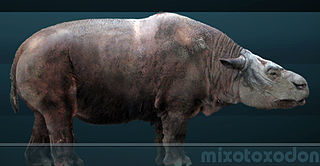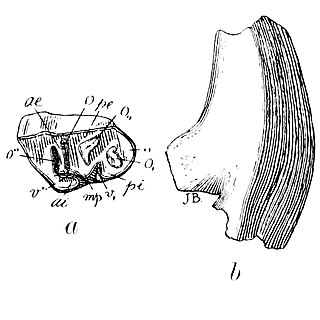Description
This genus is primarily known from a skull and a few postcranial bones, and it likely was about the size of a sheep. Pascualihippus had a high skull, with a broad, blunt muzzle, with the two first incisors forming a transverse line across the anterior part of the premaxilla, followed by a narrowing of the muzzle when viewed from above. These characteristics are somewhat similar to those found in Toxodontidae, such as Adinotherium and Nesodon . However, its incisors had roots and the cheek teeth were quite different from those of "true" toxodonts. The molars of Pascualihippus lacked the typical bifurcation on the central loop. The premaxillary dental arch was linear, indicating that it likely was a grass bruiser. Unlike its relative Eomorphippus , its incisors were not protruding.
Classification
Pascualihippus was first described in 1997, based on fossilized remains found in the Salla Formation in Bolivia, in terrains dated from the Late Oligocene. Pascualihippus was originally placed within the family Notohippidae, a family of toxodont notoungulates with horse-like teeth, with very high-crowned molars. More recent research, however, tends to indicate that this group was paraphyletic, containing increasingly derived forms, some of them close to the ancestors of "true" Toxodontidae. Pascualihippus seems to have been close to those forms, and is in more modern studies nested at the basis of a clade including its relative Argyrohippus and more derived Toxodontidae. [1]

Toxodontia is a suborder of the meridiungulate order Notoungulata. Most of the members of the five included families, including the largest notoungulates, share several dental, auditory and tarsal specializations. The group is named after Toxodon, the first example of the group to be discovered by science.

Pyrotherium is an extinct genus of South American ungulate, of the order Pyrotheria, that lived in what is now Argentina and Bolivia, during the Late Oligocene. It was named Pyrotherium because the first specimens were excavated from an ancient volcanic ash deposit. Fossils of the genus have been found in the Deseado and Sarmiento Formations of Argentina and the Salla Formation of Bolivia.

Rhynchippus is an extinct genus of notoungulate mammals from the Late Oligocene of South America. The genus was first described by Florentino Ameghino in 1897 and the type species is R. equinus, with lectotype MACN A 52–31. Fossils of Rhynchippus have been found in the Agua de la Piedra and Sarmiento Formations of Argentina, the Salla and Petaca Formations of Bolivia, the Tremembé Formation of Brazil, and the Moquegua Formation of Peru.

Notohippidae is a paraphyletic extinct family of notoungulate mammals from South America. Notohippids are known from the Eocene and Oligocene epochs.
Proadinotherium is an extinct genus of toxodontid. It lived between the Late Oligocene and the Early Miocene in what is now South America.
Gyrinodon is an extinct genus of toxodontid notoungulate that lived from the Late Miocene and Early Pliocene in what is now Brazil and Colombia.
Ethegotherium is an extinct genus of Notoungulates, belonging to the suborder Typotheria. It lived from the Lower to the Middle Miocene, and its fossilized remains were discovered in South America. It might be a synonym of the genus Prohegetotherium.

Argyrohippus is an extinct genus of notoungulate, belonging to the family Notohippidae. It lived from the Late Oligocene to the Early Miocene, and its fossilized remains were found in South America.

Periphragnis is an extinct genus of isotemnid notoungulates that lived from the Middle Eocene to the Early Oligocene in what is now Argentina and Chile.
Pleurostylodon is an extinct genus of notoungulate belonging to the family Isotemnidae. It lived during the Middle Eocene, in what is now Argentina.
Rhyphodon is an extinct genus of notoungulate, who lived from the Middle to the Late Eocene in what is today South America.

Eomorphippus is an extinct genus of notohippid notoungulate that lived from the Late Eocene to the Early Oligocene in what is today South America.
Eurygenium is an extinct genus of notoungulate belonging to the family Notohippidae. It lived during the Late Oligocene in what is today South America.

Morphippus is an extinct genus of notohippid notoungulate that lived during the Middle to Late Oligocene in what is now South America.
Anayatherium is an extinct genus of notoungulate belonging to the family Leontiniidae. It lived during the Late Oligocene, and its fossilized remains were discovered in South America.
Colpodon is an extinct genus of herbivorous mammal, belonging to the order Notoungulata. It lived during the Early Miocene, in what is today Argentina and Chile, in South America.
Sallatherium is an extinct genus of Notoungulate, belonging to the suborder Typotheria. It lived during the Late Oligocene, and its fossilized remains were discovered in South America.
Teushentherium is an extinct genus of notohippid notoungulate from the Oligocene of Argentina. Fossils have been found in the Sarmiento Formation of Argentina.
Rosendo is an extinct genus of notohippid notoungulates that lived during the Early Oligocene in what is now Argentina and Chile. Fossils of this genus have been found in the Sarmiento Formation and the Abanico Formations of Argentina and Chile.
Moqueguahippus is an extinct genus of notohippid notoungulates that lived during the Late Oligocene of what is now Peru. Fossils of this genus have been found in the Moquegua Formation of Peru, which it was named after.
This page is based on this
Wikipedia article Text is available under the
CC BY-SA 4.0 license; additional terms may apply.
Images, videos and audio are available under their respective licenses.















